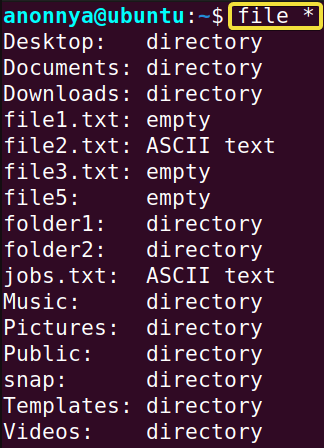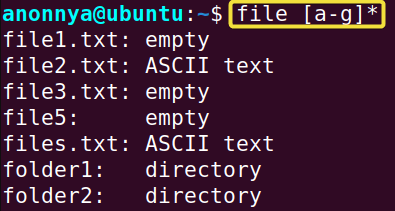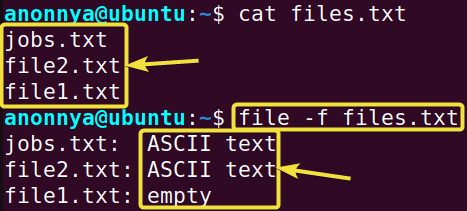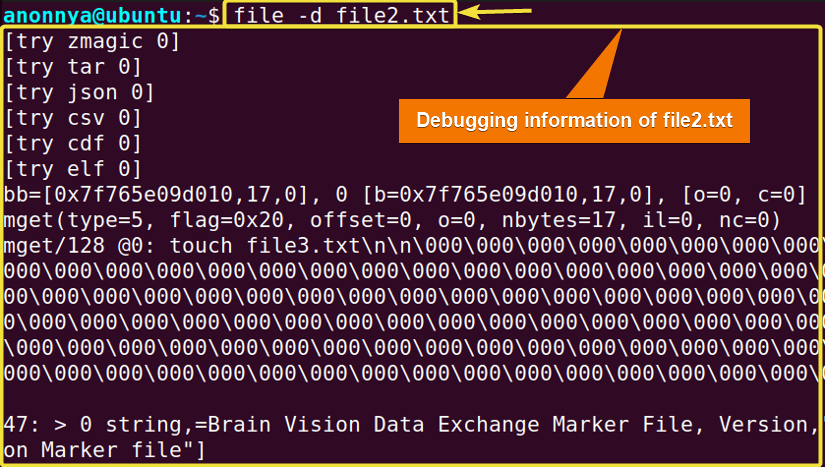FUNDAMENTALS A Complete Guide for Beginners

The file command in Linux determines the types of files on your system. It runs tests on the provided file/s to categorize them and then displays the final output. In this article, I will demonstrate the uses of the file command with practical examples.
A. Description
The file command in Linux tests each file passed as an argument to determine its classification. During the process, the system runs three types of tests and the succeeding test determines the file type. The descriptions of these tests are given below.
- filesystem test: Checks whether the file is empty or if it is of a special type. This test examines the return from a stat system call.
- magic test: Checks for files with fixed data formats. It uses the concept of “magic number” that indicates extensions of data files.
- language test: Determines in what language the file is written. It looks for a particular string that can appear anywhere in the first few blocks of the file.
B. Syntax
The syntax of the file command in Linux simply contains single or multiple options and then the desired Filenames.
file [OPTION]... FILE …C. Options
The file command in Linux offers several options to modify your experience with files. You will find the most useful ones here for your convenience. For further features, you can look at the man page.
man fileUseful Options
- -b: Does not print filenames with output.
- -c: Prints out the parsed form of the file.
- -d: Shows debugging information of a file.
- -f: Reads file names from a namefile.
- -i: Gives mime-type strings as output.
- -s: Determines the type of special files.
- -z: Determines the type of compressed files.
NB: The options in Linux CLI (Command Line Interface) are all case-sensitive, So be cautious while using them.
Practical Examples of the “file” Command in Linux
The file command in Linux is a useful command used to learn about the files available on your machine. In this section, I will illustrate some of the most helpful applications of the file command.
Example 1: Determining the Type of a File Using the “file” Command in Linux
You can determine the type of a certain file using the file command in Linux. In this example, I will find out the type of the file “jobs.txt”. To do so you can follow the steps below.
Steps to Follow >
➊ At first open the Ubuntu Terminal.
➋ Type the following command in the command prompt:
file jobs.txt➌ Now, press the ENTER button.
Output >
In the image below, you can see that I have displayed the type of the desired file.
Example 2: Determining Types of Multiple Files Using the “file” Command in Linux
You can find out the types of multiple files using the file command in Linux. You can provide a list of files separated by a space or pass regex ranges to indicate the number of files. Below are some examples of accessing multiple files using the file command in Linux.
Case A: Printing Types of All Files Available in the Current Directory
To display all the file types in the current directory use the wildcard character “*” and follow the steps below.
Steps to Follow >
➊ At first go to the Ubuntu Terminal.
➋ Type the following command in the command line:
file *➌ Now, press ENTER.
Output >
In this given image, you can see that I have shown all the file types available in my current directory.
Case B: Printing Types of All Files Available in a Specified Directory
To print all the file types of a specific directory follow the below process.
Steps to Follow >
➊ At the first launch the Ubuntu Terminal.
➋ Write the following command in the command prompt:
file Downloads/*➌ Hit the ENTER button.
Output >
In the following image, you can see that I have displayed the types of all the files available in the “Downloads/” directory.
Case C: Printing Types of Files From a Given List
To print types of files from a given list follow the below steps.
Steps to Follow >
➊ At first open the Ubuntu Terminal.
➋ Type the following command in the command prompt:
file jobs.txt file2.txt file1.txt➌ Now, press the ENTER button.
Output >
In the given image, you can see that I have printed types of all 3 files provided within a list.
Case D: Printing Types of Filenames in a Range
You can find types of a set of files by providing a regex style range with the help of the file command in Linux. You need to place a range inside square brackets and assign the wildcard character “*” with it. However, remember that the result for this command will be case-sensitive. In this example, I will print the files with names in the range [a-g]. To do the same follow the given procedure.
Steps to Follow >
➊ At first open the Ubuntu Terminal.
➋ Type the following command in the command prompt:
file [a-g]*➌ Now, press the ENTER button.
Output >
In this image, you can see that I have printed all the files having names starting with a-g.
Similar Readings
- The “pwd” Command in Linux [4 Practical Examples]
- The “cd” Command in Linux [6 Practical Examples]
- The “ls” Command in Linux [7+ Practical Examples]
Example 3: Examining Files Listed on a Text File Using the “file” Command in Linux
You can examine a list of files written on another text file using the file command in Linux. To do so you will need to use option -f. In this example, I will find out the types of files written on the namefile “files.txt”. You can follow the steps below to do the same.
Steps to Follow >
➊ At first go to the Ubuntu Terminal.
➋ Type the following command in the command prompt:
file -f files.txt➌ Press the ENTER button.
Output >
In the image below, at first, I showed you the namefile contents using the cat command. Then, you can see that I have displayed all the file types from the namefile.
Example 4: Testing Special Files Using the “file” Command in Linux
You can determine the type of special files (i.e. Device files etc.) using the file command in Linux with the option -s. You will need to run commands as a superuser using the keyword sudo to access the special files. In this example, I will find out the type of the special file “sda1”(The sda1 is a special file because it is a device file that represents the first partition of the hard disk.). To do so you can follow the steps below.
Steps to Follow >
➊ Launch the Ubuntu Terminal.
➋ Type the following command in the command prompt:
sudo file -s /dev/sda1➌ Hit ENTER.
Output >
In the image given, you can see that I have displayed the type of the desired special file.
Example 5: Testing Compressed Files Using the “file” Command in Linux
You can find out the type of compressed files using the file command in Linux with the option -z. In this example, I will find out the type of the compressed file “compressedfile.zip”. To do the same you can follow the below steps.
Steps to Follow >
➊ At first open the Ubuntu Terminal.
➋ Type the following command in the command prompt:
file -z compressedfile.zip➌ Type your Password.
❹ Now, press the ENTER button.
Output >
In the following image, you can see that I have shown the type of the “compressedfile.zip” file.
Example 6: Testing Parsed Version of a File Using the “file” Command in Linux
You can test a parsed version of a file using the file command in Linux with the option -c. The parsed version of a file contains the rules and patterns used by the system for the file’s magic test. In this example, I will display the check printout for the parsed version of the file “file2.txt”. To do so you can follow the given process.
Steps to Follow >
➊ At the first launch the Ubuntu Terminal.
➋ Type the following command in the command prompt:
file -c file2.txt➌ Now, hit the ENTER button.
Output >
In the image below, you can see that I have printed the parsed version of the file “file2.txt”.
Example 7: Displaying File Types in Brief Mode Using the “file” Command in Linux
You can display file types in a brief mode using the file command in Linux. To do so you will need to use option -b. In this case, the output will not show the file names. In this example, I will display the types of files jobs.txt, file2.txt, and file1.txt in brief mode. You can follow the steps below to do the same.
Steps to Follow >
➊ Go to your Ubuntu Terminal.
➋ Write the given command in the command prompt:
file -b jobs.txt file2.txt file1.txt➌ Now, press ENTER.
Output >
In the following image, you can see that I have displayed the desired file types in brief mode.
Similar Readings
- The “mv” Command in Linux [8 Practical Examples]
- The “cp” Command in Linux [6 Practical Examples]
- The “rm” Command in Linux [7 Practical Examples]
Example 8: Displaying Mime Type of a File Using the “file” Command in Linux
You can display the mime type of a file using the file command in Linux with the option -i. The mime type is actually a string that enables the system to identify the type of a file. In this example, I will find out the mime type of the file “file2.txt”. You can do the same by following the steps below.
Steps to Follow >
➊ Launch the Ubuntu Terminal.
➋ Type the following command in the command prompt:
file -i file2.txt➌ Hit the ENTER button.
Output >
In the given image, you can see that I have displayed the mime type of the desired file. Here, the mime type “text/plain” indicates that the file is a plain text file.
Example 9: Printing Internal Debugging Information of a File Using the “file” Command in Linux
You can print the internal debugging information of a file using the file command in Linux with the option -d. In this example, I will view the debugging information of the file “file2.txt”. You can do the same by following the given process.
Steps to Follow >
➊ Open the Ubuntu Terminal.
➋ Type the following command in the command prompt:
file -d file2.txt➌ Press the ENTER button.
Output >
In the image below, you can see that I have displayed the debugging information of the desired file.
Conclusion
In this article, I have tried to present you with the frequent uses of the file command in Linux with practical examples. Using this command, you will be able to examine and learn about files available on your system. I hope the practical knowledge gained from this article will help you experience the command line and make you a power user of Linux.
Similar Readings
- The “touch” Command in Linux [8 Practical Examples]
- The “mkdir” Command in Linux [6+ Practical Examples]
- The “locate” Command in Linux [7 Practical Examples]
- The “find” Command in Linux [10+ Practical Examples]
- The “chmod” Command in Linux [6 Practical Examples]
- The “chown” Command in Linux [8 Practical Examples]















